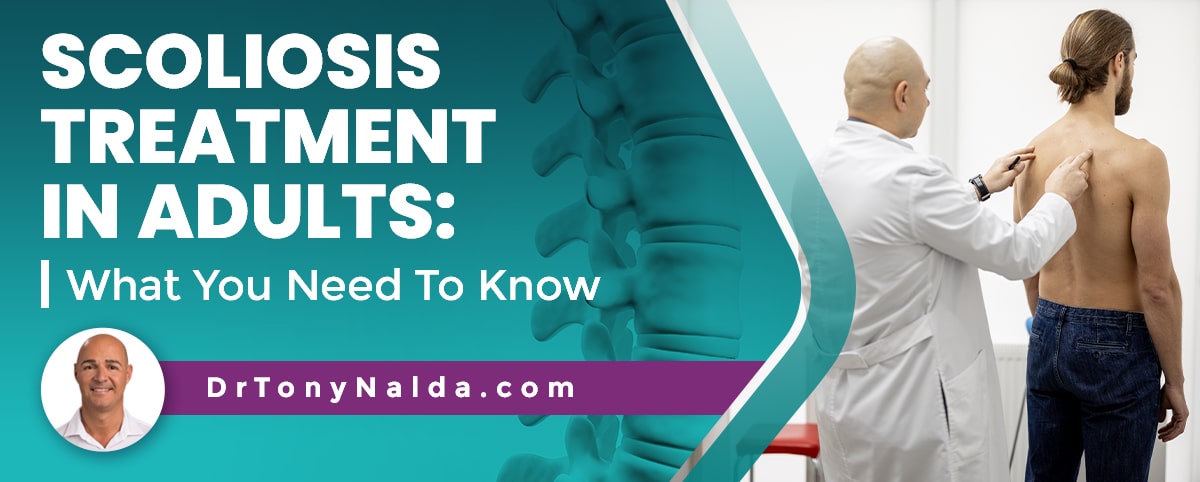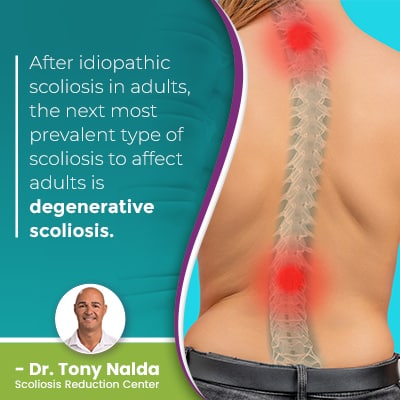Scoliosis Treatment In Adults: [ What You Need To Know ]

Scoliosis is a complex spinal condition that needs a customized treatment approach. Not only does the condition range so widely in severity, there are also different types that develop, and different types have different treatment needs. While the goal of treating childhood scoliosis and adult scoliosis is similar, the focus varies; continue reading to find out why.
Scoliosis affects all ages. The condition is most common in children, particularly adolescents, but it also affects adults. The two main types of scoliosis to affect adults are idiopathic scoliosis and degenerative scoliosis.
Scoliosis is a highly-prevalent progressive spinal condition that warrants awareness.
Table of Contents
What is Scoliosis?
Current estimates of the Scoliosis Research Society have close to seven million people currently living with scoliosis in the United States alone, and keep in mind, that estimate only includes known diagnosed cases.
Scoliosis isn't always easy to recognize and diagnose; its signs can be subtle, and it ranges widely in severity.
Being diagnosed with scoliosis means an unnatural curvature of the spine has developed, and the unnatural spinal curve bends to the side and rotates, making it a complex 3-dimensional condition.
When scoliosis is diagnosed, it's also classified based on important patient/condition variables, and these include patient age, condition type, curvature location, and severity.
Each case of scoliosis is unique, which is why treatment plans have to be 100-percent customized to address those classification-points.
Patient Age
 Patient age is an important factor not only because it can indicate a patient's overall health, but also because it helps shape a person's experience of life with scoliosis.
Patient age is an important factor not only because it can indicate a patient's overall health, but also because it helps shape a person's experience of life with scoliosis.
Patient age greatly affects pain and progression; scoliosis doesn't become a compressive condition until skeletal maturity has been reached, and it's compression of the spine and its surrounding muscles and nerves that causes the majority of condition-related pain.
So childhood scoliosis isn't commonly known as painful because the constant lengthening motion of a growing spine counteracts the compressive force of the unnatural spinal curve, but in adult scoliosis, the main symptom is pain.
Adult scoliosis pain will vary based on a number of factors and can include back pain, muscle pain, and pain that radiates into the extremities due to nerve compression.
So when treating young scoliosis patients, there doesn't have to be a focus on pain relief and management, but when treating adult patients with scoliosis, a focus of treatment is pain relief.
While the goal of treating scoliosis in young patients is to achieve a significant curvature reduction and hold it there despite the constant trigger of growth, the goal of adult scoliosis treatment is still on achieving curvature reductions, but is more about reducing a scoliosis back to where it was prior to becoming painful.
As a progressive condition, scoliosis has it in its nature to get worse over time, and the biggest trigger for scoliosis progression is growth, so again, an important difference between adult and childhood scoliosis is the potential rate of progression; young patients are more at risk for rapid progression than adults.
So the treatment of adult scoliosis also doesn't have to focus as much on counteracting the condition's progressive nature because rapid-phase progression isn't as likely; scoliosis progression tends to slow once skeletal maturity has been reached.
Condition Type
Condition type is important and is determined by causation.
Most cases of scoliosis are classified as idiopathic scoliosis, meaning not clearly associated with a single-known cause, and this type accounts for approximately 80 percent of known diagnosed cases; the remaining 20 percent are associated with known causes.
Neuromuscular scoliosis patients have developed scoliosis as a related complication to a larger neuromuscular medical condition such as spina bifida, muscular dystrophy, and/or cerebral palsy.
Congenital scoliosis is caused by spinal malformations that develop as the spine is forming in utero.
Degenerative scoliosis is caused by natural age-related spinal degeneration and the cumulative effect of lifestyle factors.
The two most common types to affect adults are idiopathic scoliosis and degenerative scoliosis, so let's take a closer look at each.
Idiopathic Scoliosis in Adults
 Most adults with scoliosis have idiopathic scoliosis, and these patients had the most common type of scoliosis, adolescent idiopathic scoliosis, but were neither diagnosed, nor treating during adolescence; this is a common scenario because adolescent idiopathic scoliosis isn't always easy to diagnose.
Most adults with scoliosis have idiopathic scoliosis, and these patients had the most common type of scoliosis, adolescent idiopathic scoliosis, but were neither diagnosed, nor treating during adolescence; this is a common scenario because adolescent idiopathic scoliosis isn't always easy to diagnose.
Remember, for adolescents, having not yet reached skeletal maturity, scoliosis isn't commonly painful; in adult scoliosis, it's pain that brings the majority of older adults in for a diagnosis and treatment.
And as scoliosis ranges so widely in severity from mild to moderate and severe to very severe scoliosis, when mild, it's even harder to recognize.
After idiopathic scoliosis in adults, the next most prevalent type of scoliosis to affect adults is degenerative scoliosis.
Degenerative Scoliosis
As mentioned above, degenerative scoliosis is caused by natural age-related spinal degeneration and lifestyle factors and tends to affect older adults.
The body is subject to degenerative changes with age, and the spine is no exception. Oftentimes, it's the spinal discs that sit between adjacent vertebrae that are the first spinal structures to feel the effects of degeneration.
When the spinal discs start to deteriorate, as the vertebrae attach to the disc in between, if the disc starts to change shape and becomes desiccated, it affects the positioning of nearby vertebrae and can disrupt the spine's ability to maintain its natural curves and alignment.
In addition to age-related changes to the spine, lifestyle factors that can affect a person's level and rate of degenerative changes include carrying excess weight, leading a sedentary lifestyle, consuming excessive amounts of alcohol and/or smoking, chronic poor posture, and repeatedly lifting heavy objects incorrectly and straining the back.
When treating degenerative scoliosis in adults, the focus is on preserving spinal function, reducing curves back to where they were before becoming noticeably painful, and improving spinal support and stabilization.
So let's now talk about the actual process of treating adult scoliosis.
Adult Scoliosis Treatment Options
So we've talked generally about scoliosis treatment for adults, along with different characteristics of adult scoliosis such as potential progressive rates, causes, and symptoms.
When it comes to treating adult scoliosis, there are two main treatment approaches to choose between; one offers surgical treatment and the other offers nonsurgical treatments as a less-invasive alternative.
While traditional scoliosis treatment tends to funnel patients towards spinal fusion surgery, the reality is that many patients with scoliosis don't require surgical treatment.
Spinal surgery is invasive, costly, and risky, and involves fusing the curve's most-tilted vertebrae into one solid bone and commonly includes attaching metal rods to the spine to hold it in place; hardware attached is permanent.
Modern conservative treatment is what I offer patients of the Scoliosis Reduction Center, and this approach is integrative; it combines multiple scoliosis-specific treatment disciplines so conditions can be impacted on every level.
Chiropractic care works towards reducing the size of the scoliotic curve on a structural level, and this involves a series of techniques and manual adjustments that can adjust the position of the curve's most-tilted vertebrae back into alignment with the rest of the spine.
Once I start to see structural results, I focus on increasing core strength so the spine's surrounding muscles can optimally support and stabilize the spine: two of the main treatment goals in adult scoliosis.
Physical therapy and scoliosis-specific exercises and stretches can also help address any related muscle imbalance, improve posture, and can also help stimulate specific areas of the brain for enhanced brain-body communication.
Corrective bracing can be another facet of a conservative treatment plan, and when treating children with scoliosis, the focus of bracing is to help augment corrective treatment results, and it can do this by pushing the spine into a corrective position, but in adult scoliosis treatment, bracing is prescribed more for stabilizing the spine and short-term pain relief.
Rehabilitation involves a series of custom-prescribed home exercises so adult patients can continue to stabilize and heal their spines from home, and guidance on how to lead a spine-friendly lifestyle is also important for preserving spinal health and function.
Conclusion
Adult scoliosis patients will have a different experience than young patients for whom the condition is not yet compressive.
For children, the main scoliosis symptom is postural deviation: uneven shoulders, shoulder blades, the development of a rib cage arch, and uneven hips.
In adults, the main symptom of scoliosis is back pain and pain radiating into the extremities due to spinal nerves being compressed; adults with scoliosis still experience postural changes, but pain is the more noticeable effect.
Scoliosis causes a spinal imbalance, and this doesn't just affect the spine and its immediate surroundings, but also the entire body as it disrupts its center of gravity, disrupting balance, coordination, and gait.
An abnormal curvature of the spine introduces a lot of uneven forces to the body, and non-operative treatment has the goal of restoring as much balance as possible.
The two most common types of scoliosis to affect adults are idiopathic and degenerative, and regardless of severity, as a progressive condition, the best time to start treatment is always now.
Dr. Tony Nalda
DOCTOR OF CHIROPRACTIC
After receiving an undergraduate degree in psychology and his Doctorate of Chiropractic from Life University, Dr. Nalda settled in Celebration, Florida and proceeded to build one of Central Florida’s most successful chiropractic clinics.
His experience with patients suffering from scoliosis, and the confusion and frustration they faced, led him to seek a specialty in scoliosis care. In 2006 he completed his Intensive Care Certification from CLEAR Institute, a leading scoliosis educational and certification center.
About Dr. Tony Nalda
 Ready to explore scoliosis treatment? Contact Us Now
Ready to explore scoliosis treatment? Contact Us Now





